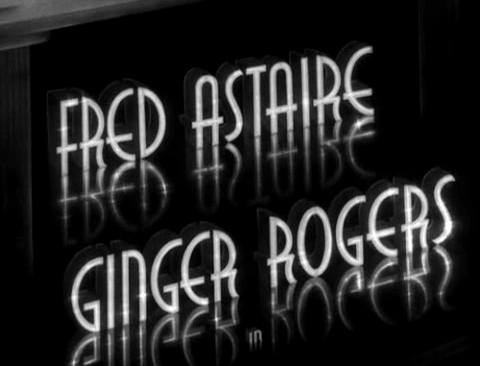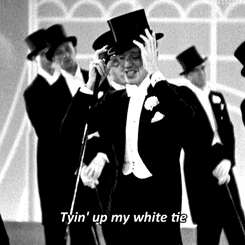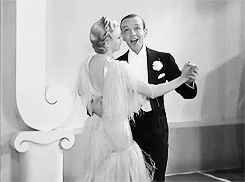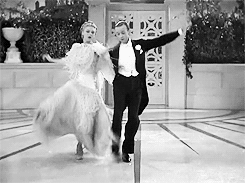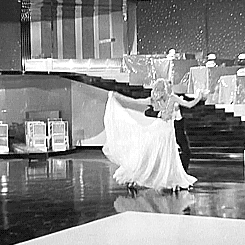Top Hat (1935) Trailer
No Strings
Isn't it a Lovely Day
TOP HAT, WHITE TIE AND TAILS
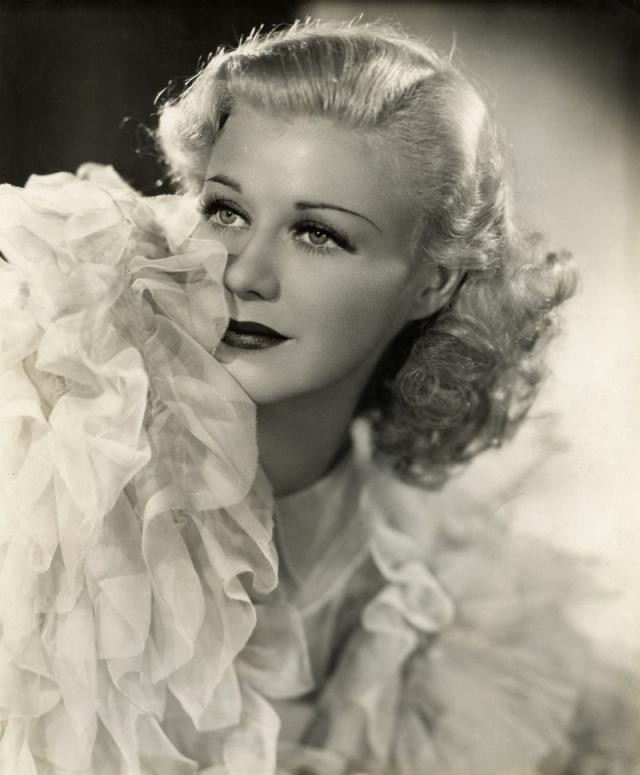
Ginger Rogers (Independence (Missouri), 16 juli 1911 - Rancho Mirage (Californië), 25 april 1995) werd geboren als Virginia Katherine McMath en was een Amerikaans actrice en danseres.
Ze is het best bekend als partner van Fred Astaire in een serie van 10 zingende-dansende Hollywood musicals, maar haar acteercarrière overspant 30 jaar. Haar eerste rollen waren in een drietal korte films in 1929 - Night in the Dormitory, A Day of a Man of Affairs, en Campus Sweethearts. In 1939 speelde ze tegenover David Niven in Bachelor Mother.
In 1940 won ze de Oscar voor beste actrice voor haar hoofdrol in Kitty Foyle. Rogers was 5 keer getrouwd en 5 keer gescheiden.
Ze overleed in 1995 en werd, net als Fred Astaire, begraven op de Oakwood Memorial Park begraafplaats in Chatsworth in Californië.
Ginger Rogers was een van de favoriete imitaties van korporaal Beaumont in It ain't half hot mum.
Cheek to Cheek
The Piccolino
Fred Astaire and Ginger Rogers's first movie together was Flying Down to Rio.
Fred Astaire (May 10, 1899 – June 22, 1987) and Ginger Rogers (July 16, 1911 – April 25, 1995) were iconic dance partners who made motion pictures together from 1933 to 1949. They made a total of 10 films, nine of them with RKO Radio Pictures from 1933 to 1939, and one, The Barkleys of Broadway, with M-G-M in 1949, their only color (Technicolor) film.
Beginning (1933–1935)
Astaire started dancing in the early 1900s as a child on stage, in Vaudeville, partnering with his older sister, Adele. He made his first movie in 1933, taking on a small role in the movie Dancing Lady starring Clark Gable and Joan Crawford. Rogers made her first appearance in a 1929 movie short, then made feature Pre-Code movies with Warner Brothers Pictures such as 42nd Street and Gold Diggers of 1933.
Astaire and Rogers made their first pairing in a movie in 1933, Flying Down to Rio, in which they had supporting roles; the main star was Dolores Del Rio. The film, released late in 1933, earned worldwide rentals of $1.5 million.
In 1934, Astaire and Rogers made the musical movie The Gay Divorcee which co-starred Edward Everett Horton; it was their first joint starring role in a movie and grossed even more with worldwide rentals of $1.8 million; the movie also featured the classic Cole Portersong "Night and Day". The song "The Continental" from the movie was a hit and was also the first song to win the Academy Award for Best Original Song in the 1934 Academy Awards.
1935
Astaire and Rogers made two movies in 1935, Roberta, which featured the song "I Won't Dance" and Top Hat, which also co-starred comedian Edward Everett Horton.
In Roberta, Astaire and Rogers had a supporting role with Irene Dunne starring. In this film, the song and dance, "I'll Be Hard to Handle", was an early example of the electricity and vivacity of the pairing. It was RKO's biggest hit of the 1934-1935 season with worldwide rentals of $2.3 million.
Top Hat marked the first time the duo had a film written solely for them, and it proved to be one of the most successful films of the year with worldwide rentals of $3.2 million. It was the most profitable film RKO made in the 1930s with profits of $1.3 million.
They were voted fourth on the Top Ten Money Making Stars Poll published by Quigley Publishing Company.
Later years
By 1936, Astaire and Rogers were top box office names. That year they made another two movies together: Follow the Fleet and Swing Time, which were both hits, earning worldwide rentals of $2.7 million and $2.6 million respectively.
Follow the Fleet boasted another Irving Berlin score, which featured the well known vignette "Let's Face the Music and Dance".
Swing Time spawned the Oscar-winning song "The Way You Look Tonight", written by Jerome Kern with lyrics by Dorothy Fields, which Astaire sang to Rogers. John Mueller has cited Swing Time for possessing "the greatest dancing in the history of the universe.". The dance sequences for Swing Time (e.g. "Never Gonna Dance")[6] are considered by Arlene Croce to be the high point of their art. This scene took 47 takes to perfect, during which the dancers had to ascend stairs, spinning, until they perfected it. By the end of the shoot, Rogers' feet were bleeding.
They were voted the third biggest money making stars of the year in the annual Quigley poll.[9]
1937
1937 featured only one movie for Astaire and Rogers, Shall We Dance, which co-starred Edward Everett Horton. Although the film was RKO's biggest film of the year with worldwide rentals of $2.2 million, it did not perform as well as expected by the studio.[10] Shall We Dance had the first Hollywood score by the brothers George and Ira Gershwin, and included the song "They Can't Take That Away from Me". Although Astaire and Rogers would go on to make two more films together for RKO, the film's comparative disappointment in the box office was the beginning of the end for their partnership.
1938
After an unusually long period apart, Astaire and Rogers made only one movie together in 1938, the 80-minute Carefree. During their time apart, Rogers appeared in the successful movie Stage Door, while Astaire's career did not reach the same heights he had experienced with Rogers.The duo reunited, but Carefree marked a departure for their on-screen partnership, featuring Astaire in a role unlike his usual typecast persona, as well as less emphasis on the musical element of the film. Carefree was originally going to contain sequences shot in Technicolor, but RKO considered the cost prohibitive so it was filmed in black and white. This movie feature an Irving Berlin musical score with only four songs, the fewest in any Astaire and Rogers film. While the film was well-received by critics, with Motion Picture Herald's William R. Weaver calling it "the greatest Astaire-Rogers picture", it was their most expensive film to date costing $1.3 million and ultimately lost money for the studio despite earning worldwide rentals of $1.7 million.
1939
In 1939, Astaire and Rogers made The Story of Vernon and Irene Castle. It was the end of their partnership for ten years, until they reunited for The Barkleys of Broadway. Although their relationship was amicable, both wanted to explore new avenues. Rogers was interested in more dramatic roles than those she was offered with Astaire. Meanwhile Astaire, who worked with many dancers throughout his career, no longer wanted to be paired with one permanent partner.
Despite several successful films, RKO was facing bankruptcy. Due to the high cost and low profit of recent Astaire-Rogers vehicles, along with the stars' mutual desire to branch out, RKO announced the end of the on-screen partnership. Their farewell film was a musical biography of ballroom dancers Vernon and Irene Castle. When Astaire and Rogers filmed the last dance in this film, Missouri Waltz, they attracted a large crowd of co-workers and crew members from RKO and numerous other studios, all of whom attended to bid an emotional farewell to the great dance team. The film earned worldwide rentals of $1.8 million but again did not make a profit.
Solo years
Rogers had long been keen to pursue more dramatic roles, which she successfully managed after her split from Astaire. At the 1941 Academy Awards ceremony, Rogers won the Academy Award for Best Actress for her performance in Kitty Foyle and by the mid-1940s she was the highest paid actress in Hollywood, although her career waned post war.
Astaire continued to make musicals including Holiday Inn (1942) with Bing Crosby, Sky's The Limit (1943) with Joan Leslie and Blue Skies (1946), his second and last movie with Crosby. He also partnered with numerous other dancers, including Rita Hayworth, Cyd Charisse and Judy Garland. Fearing his career was failing, Blue Skies was due to be Astaire's last film, after which he retired for two years. In 1948 Gene Kelly was due to star in MGM's Easter Parade alongside Judy Garland, but he broke his ankle, and MGM convinced Astaire to fill in, ending his retirement.
1949 and later
Due to their success as a partnership, Garland and Astaire were due to reunite for The Barkleys of Broadway, but Garland was forced to drop out and Rogers took her place. The film, released in 1949, reunited Astaire and Rogers for their only movie for MGM and their only color film. During production, Astaire received an honorary Academy Award, which was presented to him by Rogers. This film was greeted with joy by critics, who were thrilled to see the partnership together once again. It was a success, earning a worldwide total of $5,421,000 on an estimated budget of $2,325,420. The Barkleys of Broadway would be Astaire and Rogers' final movie together, although both would continue to make films with other stars. In the 50s, Rogers' movie career declined due to a move away from classic film stars, but Astaire remained in the industry and branched out into television.
Filmography
| Title | Year |
|---|---|
| Flying Down to Rio | 1933 |
| The Gay Divorcee | 1934 |
| Roberta | 1935 |
| Top Hat | 1935 |
| Follow the Fleet | 1936 |
| Swing Time | 1936 |
| Shall We Dance | 1937 |
| Carefree | 1938 |
| The Story of Vernon and Irene Castle | 1939 |
| The Barkleys of Broadway | 1949 |
Welkom bij Clubs!
Kijk gerust verder op deze club en doe mee.
Of maak zelf een Clubs account aan:
- Fred Astaire in TV series (03:09)
- Groetjes (17:26)
- Top Hat: Monday 14:50 BBC TWO (19:10)
- Vrijdag 1 mei Top Hat (00:52)
Statistieken

Nieuwste Leden

| en) IMDb-profiel | ||
| MovieMeter-profiel |
Top Hat is een Amerikaanse muziekfilm uit 1935 onder regie van Mark Sandrich. De film is de meest succesvolle film van het danskoppel Fred Astaire en Ginger Rogers. In de Verenigde Staten bracht de film $3.000.000 op. Hoewel de dansroutines in Swing Time meer befaamd zijn, wordt Top Hat door velen beschouwd als de beste film van het danskoppel.
Er werd in films als The English Patient, The Green Mile, The Next Best Thing, Billy Elliot en Angels in America veel naar "Top Hat" verwezen.
Leeswaarschuwing: Onderstaande tekst bevat details over de inhoud en/of de afloop van het verhaal.
Jerry Travers is een ster op Broadway die werkt voor producent Horace Hardwick. Wanneer hij op een avond zijn nieuwe danspasjes demonstreert aan zijn producent, is dit tot grote irritatie van Dale Tremont. De vrouw, die haar slaap hard nodig heeft, komt klagen over het geluidsoverlast. Echter, wanneer ze Jerry ontmoet, lijken ze een romantische connectie te hebben. Ze maakt de situatie echter meer ingewikkeld als ze Jerry aanziet voor Horace.
Rolverdeling
| Acteur | Personage |
|---|---|
| Fred Astaire | Jerry Travers |
| Ginger Rogers | Dale Tremont |
| Edward Everett Horton | Horace Hardwick |
| Erik Rhodes | Alberto Beddini |
| Eric Blore | Bates |
| Helen Broderick | Madge Hardwick |
Liedjes
- "No Strings"
- "Isn't It A Lovely Day?"
- "Top Hat, White Tie and Tails"
- "Cheek to Cheek"
- "The Piccolino"
Tekst en muziek van Irving Berlin.
Prijzen
De film kreeg nominaties bij verschillende prijzen:
- Academy Award
- Beste Film
- Beste Muziek
- Beste Art Direction
- Beste Dansregie
- Satellite Awards
- Outstanding Classic DVD
De film kreeg daarnaast in 1990 de National Film Registry.
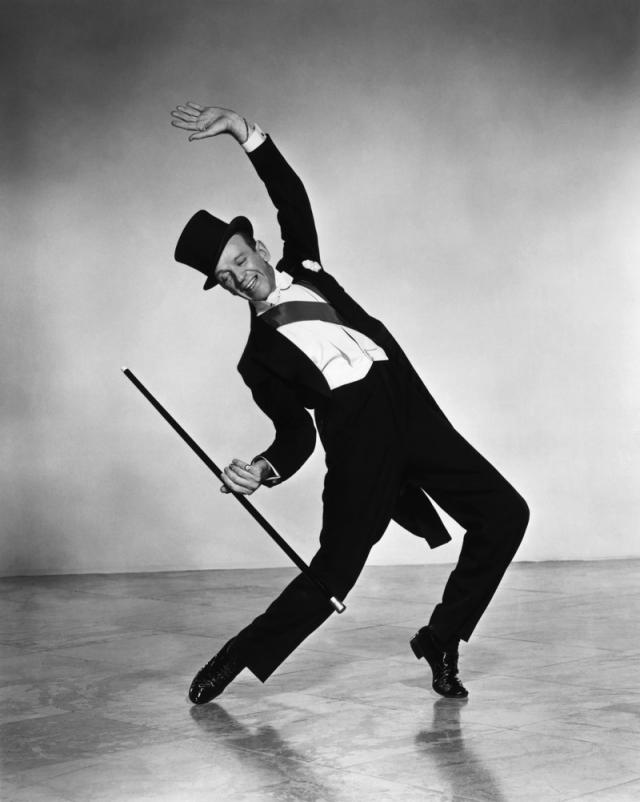
Fred Astaire, geboren als Frederick Austerlitz (Omaha (Nebraska), 10 mei 1899 – Los Angeles, 22 juni 1987) was een Amerikaans film- en Broadway ballroomdanser,
zanger en acteur. Hij wordt vaak in een adem genoemd met Ginger Rogers, met wie hij tien films maakte.
Biografie
Jeugd
"Astaire" was een naam die hij samen met zijn zus Adele had aangenomen voor hun vaudeville act toen zij ongeveer 5 jaar oud waren. Er wordt gezegd dat de naam komt van een oom die L'Astaire als achternaam had. In de jaren twintig traden Adele en Fred regelmatig op in Broadway theaters, dit hield op in 1932 toen ze haar eerste man trouwde, Lord Charles Cavendish, een zoon van de hertog van Devon.
Er gaat een bekend verhaal over de RKO Pictures screentest van Fred Astaire die werd afgewezen met "Kan niet zingen. Kan niet acteren. Wordt een beetje kaal. Kan een beetje dansen". Veel van de miljoenen fans van zijn films vonden dat hij toch wel goed kon dansen. Cole Porter schreef een aantal nummers specifiek voor hem.
Carrière[bewerken]
Hij werkte voor het eerst met Ginger Rogers in zijn tweede film Flying down to Rio. De combinatie van de twee dansers en de choreografie van Hermes Pan zorgden ervoor dat dans een belangrijk element werd van de Hollywood filmmusical. Andere films met Rogers zijn The Gay Divorcee (1934), Top Hat (1935) en Carefree (1938). Hij werkte ook met andere grote sterren, met name met Bing Crosby in de film Holiday Inn (1942) en Blue Skies (1946). Nadat hij zich terugtrok uit de showbusiness dat jaar kwam hij al snel terug naar het witte scherm om de rol van de geblesseerde Gene Kelly over te nemen in Easter Parade (1948) tegenover Judy Garland en Peter Lawford. Later speelde hij nog in The Band Wagon (1953) met Cyd Charisse.
Alhoewel hij het dansen had opgegeven bleef Astaire acteren, en verscheen in films als On the Beach (1959), Finian's Rainbow (1968), en The Towering Inferno (1974) waar hij zijn enige Oscar nominatie ontving in de categorie Best supporting Actor. Zijn laatste film was de film Ghost Story (1981).
Fred Astaire overleed in 1987 aan de gevolgen van een longontsteking en ligt net als Ginger Rogers begraven in het Oakwood Memorial Park Cemetery in Chatsworth, Californië.
